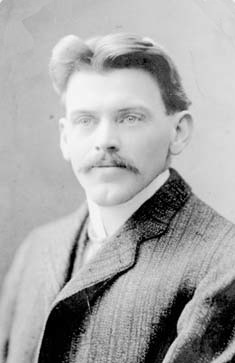
Vince Coleman. Wikipedia photo.
Today marks the 100th anniversary of the Halifax Explosion, December 6, 1917. We remember it as a great act of heroism by a telegrapher, train dispatcher Vince Coleman.

Only known photograph of the blast, probably taken about 15 seconds after detonation from about one mile away. Wikipedia photo.
The 1917 explosion in Halifax harbor killed approximately 2000 people and injured 9000 more. It represented the largest man-made explosion prior to the development of nuclear weapons, and released the equivalent of 2.9 kilotons of TNT.
It was the result of a collision between the SS Mont-Blanc, a French freighter carrying high explosives, with the Norwegian vessel SS IMO. The Imo was en route to New York to take on relief supplies for Belgium. The ship was given clearance to leave the harbor on December 5, but had been delayed due to fueling. By the time the ship had taken on fuel, the submarine nets were up for the night, and the ship had to wait.
The Mont-Blanc had arrived from New York the night of December 5 and was heavily loaded with explosives. The ship intended to join a convoy, but was also arrived too late to enter the harbor due to the submarine nets.
When the nets were lowered the next morning, the ships passed in a strait called the Narrows. At 8:45 AM, the two ships collided. While damage was not severe, barrels of Benzol broke open and flooded the hold. Sparks ignited the vapors, and a fire started at the water line. As the crew of the Mont-Blanc frantically boarded their lifeboats, they shouted warnings that the ship was about to explode.
At 9:04, the ship exploded, with a cloud of smoke rising over 11,000 feet. The shock wave was felt over 129 miles away, and an area of over 400 acres was completely destroyed. A 50-foot tsunami hit Halifax.

Halifax ruins. Wikipedia photo.
Vince Coleman, 45, was a dispatcher for the Canadian Government Railways. He, along with Chief Clerk William Lovett, was working at the Richmond station, only a few hundred feet from the pier. He was responsible for controlling trains along the main line into Halifax.
Minutes after the fire started, a sailor had been rushed ashore to warn people of the ship’s cargo. The men in the station began to rush out of the building, but Coleman hurried back to send a warning message to the other stations down the line. In particular, Coleman was aware that a passenger train was due, and that its path would take it right to the explosion. He sent the following message to all of the other stations down the line:
HOLD UP THE TRAIN. AMMUNITION SHIP AFIRE IN HARBOR MAKING FOR PIER 6 AND WILL EXPLODE. GUESS THIS WILL BE MY LAST MESSAGE. GOOD-BYE BOYS.
The message was heeded. The passenger train, with 300 aboard, was halted at Rockingham station, about 4 miles from the downtown terminal. It is almost certain the Coleman’s message saved the lives of those 300 passengers. In addition, the message, which was received by numerous other stations, along with the line then going silent, gave news of what had happened, allowing relief supplies to be immediately sent to Halifax.
This was critical, since a winter storm soon delayed further relief supplies. The passengers and crew of the first arriving trains began rendering assistance, but the first dedicated relief train was udnerway by 10:00 AM, and arrived by noon.
The next day, Halifax was blanketed by 16 inches of snow, delaying other relief trains from Canada and the United States. Coleman’s heroic message ensured that relief was on the way while there was still time to save hundreds of lives.
This short video dramatizes Coleman’s heroism:
It also features in the 2007 miniseries “Shattered City: The Halifax Explosion”:
References
- Vincent Coleman and the Halifax Explosion, Maritime Museum of the Atlantic
- Heroic dispatcher keyed warning, perished in cataclysmic Halifax explosion, Ottawa Citizen
- Chronicle-Herald
- CBC Nova Scotia

